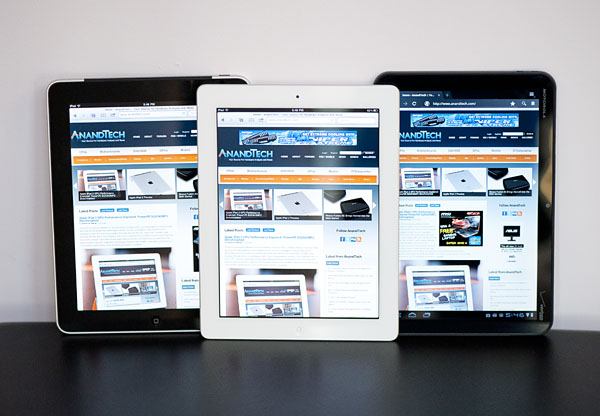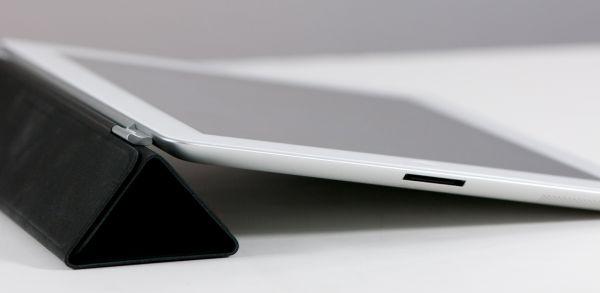Tablets: How Would You Solve the Input Problem?
by Anand Lal Shimpi on March 29, 2011 2:22 PM EST- Posted in
- Tablets
- Apple
- iPad 2
- Ask AnandTech
- Mobile
In our iPad 2 review I mentioned that despite really liking the device, I never really could integrate the original iPad into my daily life in a meaningful way. I always ended up traveling with the iPad and a notebook or while around town I just kept a smartphone on me. That limited my iPad use to pretty much lounging around at the house, and even then I found myself turning to the laptop more often than not.
With the Xoom and iPad 2 I've been giving the tablet usage model another try. I've kept my usage mostly consumption focused. Browsing the web and reading emails. I really do prefer using a tablet for both of these things. I do wish the iPad 2 was faster when selecting lots of emails but the improvement over the original iPad is still considerable.
My holdup is this: while I love reading on the iPad 2, I have troubles contributing using it. Writing lengthy email responses or even posting comments on AT is just slower on the iPad than on a notebook. The solution can't be to just walk over to a laptop when I want to respond and just use the iPad when I'm reading - that seems horrible inefficient.
I could use a Bluetooth keyboard but that's also rather clunky. I feel like there has to be a better solution going forward, particularly as the tablet market grows. Is it voice? Or some sort of an integrated kickstand with more flexibility than what you get with the smart cover?
I feel like smartphones get a pass because it's easy to type on them regardless of where you're sitting. Tablets on the other hand need to be propped up against something and as a result are harder to type on in certain situations. They work fine on a desk but if I'm at a desk I'd rather use a notebook. What about when laying back on a couch?
I'm curious what you all think about this. Am I alone in finding tablet ergonomics a barrier? If not, what do you believe is the best solution for tablets going forward. I want to read and respond on a tablet as quickly as I can on a notebook. What needs to be built? Post your comments here and I'm sure we can get many of the tablet manufacturers to pay attention. I don't think they have stumbled across the best solution for this problem either, so what you say here might go a long way in making tablets better for everyone.












247 Comments
View All Comments
mijj - Monday, April 4, 2011 - link
umm .. how about a keyboard on the back - split into two parts under where your fingers would be when you held it .. with proximity sensing showing your finger positions on the display (as if the tablet is transparent). .. i guess that means, make the back of the device touch sensitive (when needed) as well as the front.I have a vague memory of seeing this idea somewhere - no idea where tho. Maybe i dreamed or nightmared it.
Muunsyr - Monday, April 4, 2011 - link
I find it strange that we (as in big companies, particularly those trying to muscle in on ipad consumer space) haven't developed a pen to CO-EXIST with capacitive touch. Everyone knows how to write. A pen doesn't get in the way of screen real-estate, nor does it make you feel like a 'tard or a wanker when using one in public (ie, it isn't disruptive to the environment), nor is its ability to work affected by the volume of the space it is being used in (ie, the environment isn't disruptive to it). Everyone already knows how to write. And finally, it can be used for so much more than words (drawing, etc).I believe there is a product called 'Kno', which seems to have promise, although I think it should be targeted at far more than just students.
I can't see myself investing in a 'pad like device until there is a pen style input. For me this seems like the perfect combination - when a 'pad is lighter than a pad of paper, has the ability to write with a precision tool (a pen, as opposed to a finger) and has the internet, I will get one. That would be ideal.
Want to communicate an idea to a colleague, but can't express yourself? Draw a diagram.
Want to take notes in a meeting? Write them.
Want to annotate another document? Go ahead, use a pen.
Want to contribute to an Anandtech comment thread? I think you get the idea.
The above examples are all things we would either turn to a computer with a keyboard/mouse or use some good old fashioned ink for. There is no way I would have tried to peck this message out on a tablet, nor would I be able to comment with voice recognition with my girlfriend trying to watch TV next to me.
jd254 - Monday, April 4, 2011 - link
I was just talking about this last week with my friend:-make a x86 smart phone (multicore like the where the cores are not shared, but specialized for specific functions, like one will be dedicated for touchscreen only) that runs windows 7 (or what ever is the latest windows, or it can dual boot android and windows... that's up to the engineers) it will be a smart phone with a detachable slide out keyboard.
-once detached, you can attach it to a tablet terminal. the tablet will have just a screen. It's now a real tablet with an extra lb of weight.
-Now that you need real power and functionality, you add on an attachable keyboard (bluetooth keyboards are also available) Also, external graphics card has been all talk up till now, but they can make an external video card to be attached via USB 3.0 or w.e. RAM and an SSD can also be attached to the tablet. again, dual booting is up to the engineers. I don't see why this is impossible... besides for the x86 CPU designed for a phone... either develop a better battery make it REALLY efficient
789427 - Monday, April 4, 2011 - link
When I think iPod, iPad, iPhone, I immediately think sms, maybe mms, reading emails and browsing.If I think about a Blackberry though, it's business and it's emails.
I'm not suggesting that the Blackberry is good for typing 10,000 words in an email but I'd use that for IM or email over the iphone any day.
A Blackberry style keyboard would reduce the screen area so an iAlternative would be to have a split thumb operated keyboard in overlay.
What I'd do would be to put a bigger thumb keyboard split between left and right thumbs at each end of the widescreen display in overlay. This would require multi-touch and an activation button on the side or even a gesture recorded to activate input.
So the solution is, for a device that requires one or two hands to hold it, when you need to input data you need to provide an interface for the unused digits...
I did visualise a qwerty keyboard on the back of the device where your fingers naturally end up when using the device but your finger-eye coordination won't work on the reverse of the device.
cb
quickbunnie - Monday, April 4, 2011 - link
How about those 2?http://milandesignweek2011.asus.com/archives/ces-2...
andyleung - Tuesday, April 5, 2011 - link
It's interesting that Anand brings this up again but we all know that one size never fits all. In fact, we constantly love products that are designed specifically for one thing. e.g. In the old days you use scissors for everything like cutting, opening beer cap, etc. In the old days, we used one tool for all but of course it didn't work best. Nowadays, we have one tool for one thing. Meat cutting is one knife, fruit cutting is the other. So you buy 20 knife just to cut 20 different things. Environmentally it's not a good idea but they really work best for their jobs because of the one size fits one concept.Back to the topic, I don't think iPad/iPad 2 was ever designed for that kind of productivity. I could think of productivity for another type such as how Apple Store uses it as order taking platform, clicking buttons more than typing. I could imagine how hospital uses it as patient report browsing. I could also imagine how supply chain uses it in warehouse managing shipment and invoice.
If you so too keen on saying iPad/iPad 2 or any tablet is bad for typing long email, you can also say laptop or netbook is not for fast touch interactions because you MUST use mouse as pointing device.
So if one must want to do long email on tablet, all I could think of is to get the bluetooth keyboard, it's a trade off.
AverageCustomer - Tuesday, April 5, 2011 - link
Just a heads-up for all those who live in belgium and are planning to buy an iPad: people always praise Apple customer services.But in Belgium, things are not as rosy: Apple does not have stores in the country, they have "Associates". And they have a return policy VERY different from what I have read everywhere.
I have purchased an iPad 2, unfortunately it suffers from the "backlight bleeding" issue everyone has been talking about on the Apple Forums. (And, to those who doubt, yes it is a real issue. I love Apple products, but defects happen.)
So I went to exchange it, thinking: "Ok, I got a dud. No big deal. I'll get another one, and that will be the end of it."
Not possible, according to the store! They HAVE to send all Apple items for repair, and it takes 3 weeks to get a new one!
The guy in the Apple section of the store then had the nerve to tell me that I should have taken an AppleCare plan to get a replacement in 48 hours!
All that for a product that was defective right out of the box!!
So, if you are planning to buy apple gear, and live in Belgium... Watch out. NOT the same quality of service as in France, or elsewhere.
Socratic - Wednesday, April 6, 2011 - link
I think its obvious at this point that no single solution is the answer here. Users can't even agree to the utility of the tablets in the fist place. I think they serve a niche market for the casual user/novice or as one more device for the power user. They seem to be a great solution for casual e-mail use, surfing, and reading of digital content. Perhaps for more serious users the choice is that they are truely not meant for heavy/technical users. For this there is the laptop/desktop. That being said for those wanting a bridging device no single input method will suffice. I would guess there are some who would still love a functional handwriting recognition method, others a voice input method, and still others some bluetooth keyboard for typing. A single choice will never suffice, because we are all too different in what works for us.gardenian - Thursday, April 7, 2011 - link
The ipad2 cover could have a built in keyboard so when screen uncovered, keyboard becomes exposed. It would need some design work so it charges via ipad and so ipad can be propped up when typing. I'm sure apple designers could solve this though.Belard - Thursday, April 7, 2011 - link
YOu mean... something like a netbook? ;)